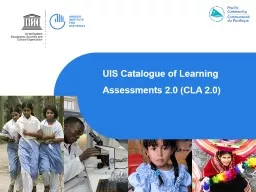

What is the Catalogue of Learning Assessments Version 2 CLA 20 What is the purpose of CLA 20 What is the scope of CLA 20 What is the structure of CLA 20 What is the relevance of CLA 20 to the monitoring of Sustainable Development Goal SDG on education ID: 915475
Download Presentation The PPT/PDF document "UIS Catalogue of Learning Assessments 2...." is the property of its rightful owner. Permission is granted to download and print the materials on this web site for personal, non-commercial use only, and to display it on your personal computer provided you do not modify the materials and that you retain all copyright notices contained in the materials. By downloading content from our website, you accept the terms of this agreement.
Slide1
UIS Catalogue of Learning Assessments 2.0 (CLA 2.0)
Slide2What is the Catalogue of Learning Assessments Version 2 (CLA 2.0)?
What is the purpose of CLA 2.0
?What is the scope of CLA 2.0?What is the structure of CLA 2.0?What is the relevance of CLA 2.0 to the monitoring of Sustainable Development Goal (SDG) on education?What are the expected products from the CLA project?What is the time framework of the CLA 2.0 implementation?Who are the UIS’ target partners for the CLA data collection?
OVERVIEW
CLA 2.0
Slide3The Catalogue
project (or CLA)
is the UIS’ initiative to compile standardised information on various aspects of learning outcomes (skills, or development) assessments in countries across the world. CLA 1.0 was lunched in 2014CLA 2.0 is an enhanced versionWhat is the Catalogue of Learning Assessments Version 2 (CLA 2.0)? CLA 2.0
Slide4Map
national, regional and international learning assessments;
Compare commonalities and differences with the objective of guiding international dialogue on what learning means, and how it is assessed and reported;Help countries evaluate and improve the quality and robustness of their assessment/examination systems; Help countries and donors identify capacity-development needs.What is the purpose of CLA 2.0?
Slide5What is the scope of CLA 2.0?
Note: *Including assessments, public examinations, and surveys
Type of assessments*School-based assessments (or survey)Household-based assessments (or survey)Both cross-national assessments and national assessments
Areas of assessment
Early childhood development
Reading, mathematics, citizenship education, education for sustainable development, environmental science, and geoscience.
ICT skills, functional literacy and numeracy, digital literacy
Target populations of assessment
Children between birth and the age at which primary schooling begins
School-age children, both in school and out-of-school
Youth and adults
Year of assessments implemented
Since 2010
Slide6What is the structure of CLA 2.0?
The CLA 2.0 consists of two modules
:Module 1 collects information about the characteristics of national and cross-national learning (skills, or development) assessments in countries. Module 2 collects the results of national learning (skills, or development) assessments as well as some key definitions of the national assessments on proficiency levels and the minimum proficiency level, for instance.
Slide7The data and information collected through the CLA 2.0 are relevant SDG 4 targets on learning outcomes (skills, or development). The specific
associated indicators include:
4.1.1 Proportion of children and young people (a) in Grade 2 or 3; (b) at the end of primary education; and (c) at the end of lower secondary education achieving at least a minimum proficiency level in (i) reading and (ii) mathematics, by sex 4.1.2 Administration of a nationally-representative learning assessment (a) in Grade 2 or 3; (b) at the end of primary education; and (c) at the end of lower secondary education 4.2.1 Proportion of children under 5 years of age who are developmentally on track in health, learning and psychosocial well-being 4.4.1 Proportion of youth and adults with information and communications technology (ICT) skills, by type of skill 4.4.2 Percentage of youth/adults who have achieved at least a minimum level of proficiency in digital literacy skills4.5.1 Parity indices (female/male, rural/urban, bottom/top wealth quintile and others such as disability status, indigenous peoples and conflict-affected, as data become available) for all education indicators on this list that can be disaggregated4.6.1 Proportion of population in a given age group achieved at least a fixed level of proficiency in functional (a) literacy and (b) numeracy skills, by sex4.7.4 Percentage of students by age group (or education level) showing adequate understanding of issues relating to global citizenship and sustainability 4.7.5 Percentage of 15-year-old students showing proficiency in knowledge of environmental science and geoscience
What is the relevance of CLA 2.0 to the monitoring of Sustainable Development Goal (SDG) on education?
CLA 2.0
Slide8Mapping
of the characteristics of
learning outcomes/skills assessments in countries worldwide;Metadata for national and cross-national learning/skills assessments; Database of national learning/skills outcomes on primary and secondary education, early childhood development, the skill levels of youth and adults, equity in education, and knowledge about global citizenshipWhat are the expected products from the CLA project?CLA 2.0
Slide9What is the time framework of the CLA 2.0 implementation?
CLA 2.0
Slide10Who are
the
UIS’ target partners for the CLA data collection?
Slide11Data to transform lives
Name and Title
Mail